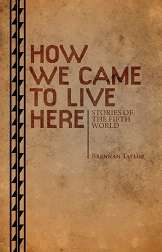How We Came To Live Here
How We Came To Live Here is an independently published role-playing game written by Brennan Taylor and published by Galileo Games.[1]
 | |
| Designer(s) | Brennan Taylor |
|---|---|
| Publisher(s) | Galileo Games |
| Publication date | 2010 (1st edition) |
| Genre(s) | Alternate history, Indie |
| System(s) | Custom |
Development
Brennan Taylor began work on a role-playing game based on the legends of the ancestral Puebloans in 2005, but had then set it aside to instead finish Mortal Coil. He began work again in fall 2006, calling it "The Fifth World", but had to change the name because of the impending publication of a post-apocalyptic RPG called The Fifth World (2006). Taylor publicly asked for comments on a number of alternative names including "Twin Souls," "Up from the Fourth World," "So That This World Will Not Be Destroyed," "Into the Light," and "How We Came to Live Here"; Taylor would eventually settle on the last, because it evoked the mythic feeling of the game.[2]:256 The game that would become How We Came to Live Here originally used the mechanics of Clinton Nixon's The Shadow of Yesterday, but Taylor found this confining, and it soon progressed from being a clone of The Shadow of Yesterday to being a game influenced by The Shadow of Yesterday. How We Came to Live Here was previewed as an online ashcan in July 2008, and then released in a final edition in March 2010.[2]:256
Setting
How We Came to Live Here has what Shannon Appelcline describes as "an evocative southwestern setting — something that was near to Taylor's heart due to his youth spent growing up in Tucson, Arizona. There's lots of background on the culture and life of the Pueblo People; Taylor builds on that by including myths in the rules text itself."[2]:257
The game is inspired by the legends and folkways of the pre-Columbian American southwest.
System
According to Shannon Appelcline,
Like The Shadow of Yesterday — and like Mortal Coil — How We Came to Live Here focuses on resource management. Player take turns framing scenes; then, when a conflict arises, they roll dice. The actual conflict is played out through players choosing dice from their rolls and then narrating the results — a system that was clearly inspired by Dogs in the Vineyard. Resources come into play when players choose to refresh traits and otherwise improve their chances at winning a contest — but in doing so give the GMs dice to use in the future.[2]:256–257
Appelcline also described two elements of the game that he found particularly notable:
First, its conflict system has an innovative result system, where players get to choose to spend their "victory dice" for specific sorts of consequences. Second, it uses two GMs, something that many indie designers have played with, but few have brought to publication. In this case, the two GMs are responsible for different sorts of threats, from the "Inside" or the "Outside."[2]:257
The game is predicated on a rich relationship map that defines both individuals and potential sources of trouble within a village. How We Came To Live Here uses Fudge dice for resolution - pools of dice with positive, null, or negative results.
References
- Taylor, Brennan (2010). How We Came To Live Here (1st ed.). Galileo Games. ISBN 978-1-934859-38-4.
- Shannon Appelcline (2014). Designers & Dragons: The '00s. Evil Hat Productions. ISBN 978-1-61317-087-8.
External links
- Galileo Games' home page for How We Came To Live Here